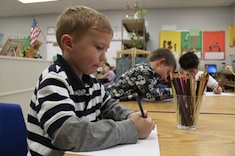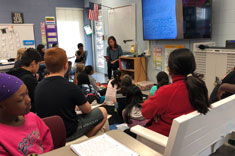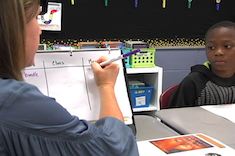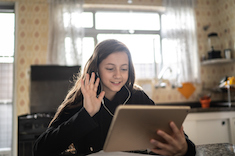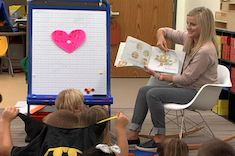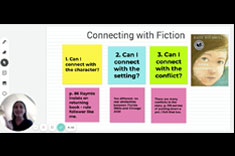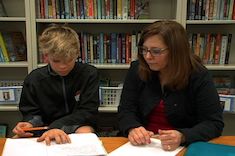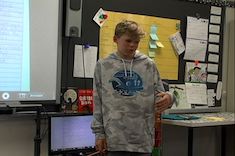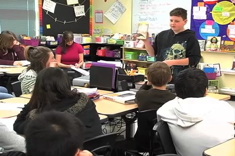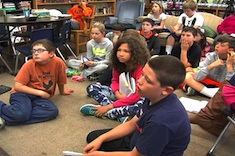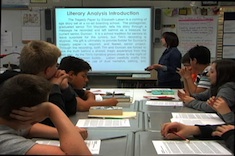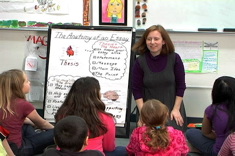Minilessons
Keeping it short, relevant, and meaningful is the challenge when it comes to designing lessons. Here is where you'll find practical advice and dozens of video examples of master teachers in action.
Latest Content
Four Ways to Use Anchor Charts in the Classroom
Tiffany Abbott Fuller provides a practical and fresh approach to organizing anchor charts in meaningful and helpful ways. Don’t miss the action-oriented summary at the end of the article to put these ideas into place in your classroom.
Reclaiming Our Time
Vivian Chen gives four steps to adjusting a lesson from the teacher’s guide to reclaim your time and make the lesson more meaningful and engaging to students.
Minilessons and Writing Instruction
Katie Linder reminds us of the importance of writing lessons to be predictable, efficient, and student-centered.
Anchor Charts: A Tool for Every Classroom
Leigh Anne Eck reflects on the importance of anchor charts and the way they help students be more independent.
Developing and Listening to Your Inner Voice During Minilessons
Katie Linder reminds us of the importance of listening to (or ignoring) our own inner voices when delivering whole-group instruction. Katie guides us in using our inner voices to make in-the-moment decisions that sharpen lessons.
The Power of an Anchor Chart in a Digital World
Dana Murphy reminds us of the power of an anchor chart in a digital world.
Whale Talk: An Asynchronous Minilesson
Gwen Blumberg teaches an asynchronous lesson for a spelling strategy.
Student-Centered Learning Through Video Lessons
Tara Barnett and Kate Mills consider the power of asynchronous lessons in creating a student-centered learning environment.
Interactive Read Aloud in Second Grade
Jen Court completes an interactive read aloud in a second-grade classroom.
Planning Writing in Kindergarten
Hayley Whitaker leads a minilesson in kindergarten on how to plan a narrative writing draft.
First Grade Minilesson: Connections
Melissa Atwood leads her first-grade class with a minilesson early in the school year on making connections to text.
Out of Sight, Out of Mind: Accountability for Young Writers
Stella Villalba teaches young writers about writer’s craft. So how come evidence of learning from the minilessons isn’t showing up when she confers with her students? She decides to develop a plan to help students link craft lessons with their writing.
Kids Teaching Kids: Student-Led Lessons
Nawal Qarooni Casiano outlines the process for empowering students to lead lessons for classmates.
Comparing Authors Minilesson
Jen Court uses text sets from three authors to help second graders ferret out different elements of the authors’ styles.
Field Notes: Preserving Minilesson Time
Ruth Ayres shows how one first-grade teacher saves precious time by not ending minilessons with lots of directions for independent work.
Introducing Social Studies Concepts with Picture Books
Mark Levine explains how picture books are powerful teaching tools in his middle school classroom.
A Minilesson on Minilessons
Franki Sibberson leads a minilesson in her fifth-grade classroom to help students design their own lessons. Students also assess what goes into a high-quality minilesson.
Thoughtful Read Aloud Structures
Franki Sibberson shares how she integrates student choice and collaboration into reading response during daily read alouds.
Reset
Christy Rush-Levine finds her students sometimes need to stop and be challenged to think in more positive ways about their reading abilities. She describes how she designs minilessons for impromptu resets in her middle school classroom.
Planning a Student-Led Minilesson
Franki Sibberson helps Lucas plan his minilesson for his fifth-grade classmates on how to connect words and facts from two different sources.
Student-Led Minilessons in Fifth Grade
Franki Sibberson initiates student-led minilessons, and finds the process takes her literacy workshops to a new level of independence and energy.
Student-Led Minilesson: Connecting Facts from Different Sources
Lucas leads a minilesson in Franki Sibberson’s fifth-grade class on connecting facts from different sources.
Student-Led Minilessons in Middle School
One student’s request to lead a minilesson is a catalyst for Mark Levine to see the value of student-led minilessons as an assignment for all in his middle school classroom.
Fall Fluster
Bitsy Parks is stressed from trying to “cover” all the lessons in the first required reading unit of the year with her first graders. She takes a deep breath and decides to integrate more of her own lessons into her instruction.
Fourth-Grade Minilesson: Character Traits
Gigi McAllister helps her fourth graders develop the characters in their writing with a minilesson. She uses three mentor texts, one of which is her own writing.
Leads Minilesson
This fifth-grade minilesson from Franki Sibberson is a lovely mix of mentor texts, Franki's own writing, and honesty about the writing process.
Object Poetry Lesson in Second Grade
Linda Karamatic explores poetry with her second graders. She displays poems students have written and teaches them about fresh language using a poem about a pencil sharpener.
Big Question Minilesson
Katherine Sokolowski models how readers make choices as questions arise while reading independently. She also demonstrates how she moves between a novel and web resources.
The Importance of Context Minilesson
Christy Rush-Levine uses a vivid anecdote from her youth to teach her middle school students about the importance of context in literary analysis.
Keeping Minilessons Short
Melanie Meehan gives three quick management tips for tackling the challenge many teachers face — keeping minilessons short.
Browse Content By
Type
Category
- Assessment Tools
- Big Fresh Archives
- Booklists
- Choice Numeracy
- Classroom Design
- Common Core
- Community Building
- Conferring
- Content Literacy
- Digital Literacy
- English Language Learners
- Equity
- Family Relations
- Free Samples
- Guiding Groups
- Leadership
- Literacy Coaches
- Mentor Texts
- Minilessons
- New Teacher Mentors
- Podcasts
- Poetry
- Quote Collections
- Reading Strategies
- Self Care
- Struggling and Striving Learners
- Talking and Listening
- Teacher Study Groups
- Teaching Reading
- Teaching Writing
- Word Study and Vocabulary
Author
- Melissa Quimby
- Nawal Qarooni
- Gwen Blumberg
- Julie Cox
- The Lead Learners
- Hannah Tills
- Josie Stewart
- Ruth Metcalfe
- Mallory Messenger
- Becca Burk
- Jodie Bailey
- Vivian Chen
- Mary Brower
- Tiffany Abbott Fuller
- Stephanie Affinito
- Ruth Ayres
- Leigh Anne Eck
- Heather Fisher
- Shari Frost
- Julie Johnson
- Suzy Kaback
- Gigi McAllister
- Shirl McPhillips
- Melanie Meehan
- Cathy Mere
- Debbie Miller
- Tara Barnett and Kate Mills
- Tammy Mulligan
- Dana Murphy
- Bitsy Parks
- David Pittman
- Brenda Power
- Heather Rader
- Matt Renwick
- Mandy Robek
- Christy Rush-Levine
- Gretchen Schroeder
- Jen Schwanke
- Brian Sepe
- Katherine Sokolowski
- Stella Villalba
- Jennifer Vincent
Grade Level
Choice Literacy Membership
Articles
Get full access to all Choice Literacy article content
Videos
Get full access to all Choice Literacy video content
Courses
Access Choice Literacy course curriculum and training



